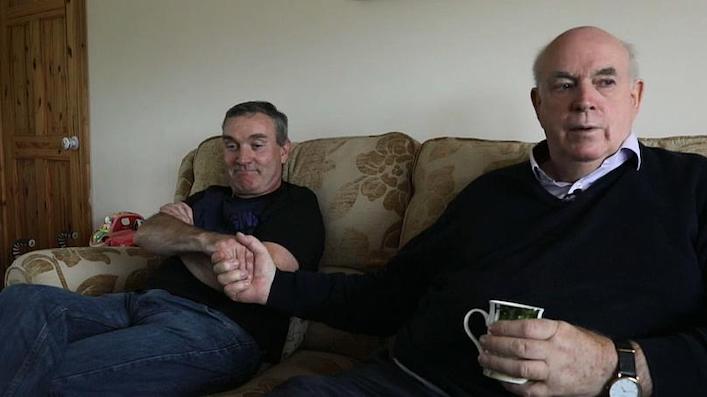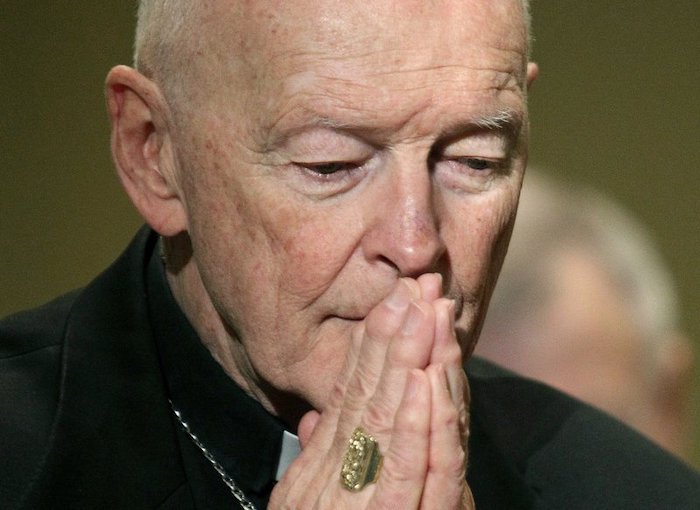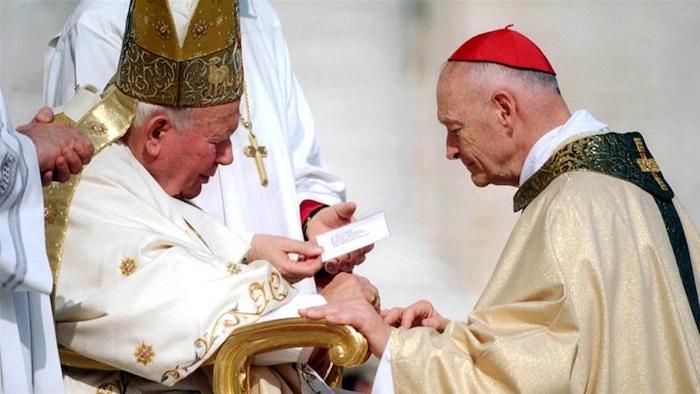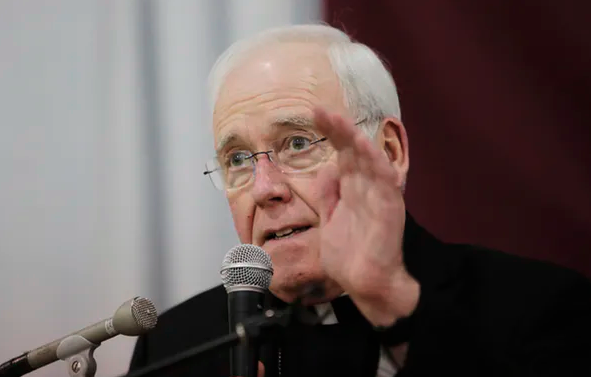— Ireland’s sex abuse survivors Access to the comments

Revelations of sexual abuse inside the Catholic church shook Ireland to its core. Unreported Europe speaks to those who survived the paedophile priests and examines if the church has truly taken responsibility for the scandal.
By Euronews
Our lives are not as normal as other people who haven’t been abused. The abuse has just changed our attitude to life, changed our attitude to people. —Martin Gallagher, Survivor
Ireland has one of the largest Catholic communities in Europe. The Church is rooted into the culture of the country, but when Pope Francis visited Dublin in 2018 his words divided the nation.
Since 2002, multiple reports and investigations have shed light on nearly 15,000 cases of sexual abuse committed in Ireland between 1970 and 1990.
The pontiff had come to apologise for those crimes carried out by members of the Church’s clergy. For many survivors, the visit and remorse that came with it was far too late.
You know, you only have to do a few Google searches to see loads of examples of popes and bishops saying ‘We didn’t know’. Like the rest of society, we didn’t understand such things were possible. They did. They lied. —Colm O’Gorman, Survivor
‘’they would laugh at us and call us liars’’
Some 500,000 of the faithful were expected to welcome Pope Francis in Dublin. In the end, only 130,000 took part in an open-air mass, a far cry from the 1 million or so who turned out 40 years earlier for John Paul ll’s visit.
The abuse inflicted by Catholic priests is believed to have led to hundreds of suicides. Those that managed to pick up the pieces and face what happened, have been named ‘The Survivors’.
Martin Gallagher is one of them. During his childhood he was sexually abused by Eugene Green, a priest in county Donegal, situated in north west Ireland.
‘’When we were younger and abused, there was nobody to talk to, that we could trust. The priests, we couldn’t go near, they would laugh at us and call us liars,’’ Gallagher told Euronews.
‘’We couldn’t tell our parents, because they would have to go to the priest, and he’d do the same thing to them. We couldn’t tell the guards, because the guards and the priests, and teachers, were all big buddies, they stuck together, so we were alone.
‘’Martin here, came along and started investigating Eugene Green, and that opened up a big page in our life, because it released a lot of pressure, anxiety, depression, all those bad feelings we were building up for years. So just by talking to Martin the first day, that lifted a big load from my shoulders, that somebody was going to help me in the end.’’
Martin Ridge, a retired police inspector was the first to hear Gallagher’s story. In 2008, Ridge published ‘Breaking the Silence’, a book detailing the investigation he conducted against Eugene Green and the abuse committed by the priest between the 1960s and 1990s.
Ridge insists the Catholic church decided not to do anything to stop decades of abuse by Green, even though there were multiple complaints filed against the priest.
‘’I was glad I was there for them, because they educated me too, and they’re educating society,’’ Ridge told Euronews.
‘’Those people are experts because they know what they’re talking about, you see…Martin doesn’t need my platitudes but I’m so grateful, and so are the public for the likes of Martin.
‘’And it is not easy….I would like to say thank you Martin again, and again, and again.‘’ Ridge said.
Thousands of child victims
Martin Gallagher’s story is not an isolated case. Allegations of sexual abuse in Ireland concern some 14,500 children for crimes committed over several decades.
In Europe, Ireland is one of the countries most affected when compared to Belgium, Germany and France, which have registered around several hundred complaints since 2010.
Most of the victims who filed claims in Ireland were in Dublin, Ireland’s biggest diocese. Between 1975 and 2004, twelve priests were responsible for two thirds of the allegations filed in the capital.
In response, the diocese put into place the Child Safeguarding and Protection Service in 2002, alongside an agency run by the state. Andrew Fagan has been its director and coordinator since 2010.
‘’When it became known that, you know, priests had behaved in an abusive way towards children, that was understood as a problem for the priest, not as a problem for the child, or for other children.
‘’For a long time, it’s not as if the diocese and authorities didn’t do anything about those situations, they did do things, but they were all about trying to fix up the priest and send him back, and they were not child centered, you know, they did not prioritise the safety of children.
‘’Even though lots of things have changed, I’m not sure the perception has changed. I think that a lot of people still think it’s a bit risky to allow your children to be involved in church activities, so I would say that there are a lot of parents who have made a decision to distance themselves from the church,’’ Fagan said.
‘’I was raped with the burning candle’’
48-year-old Darren McGavin is another survivor of sexual abuse. His abuser, Tony Walsh, is currently in prison for raping more than 200 children in the suburb of Ballyfermot, where Darren grew up in a violent family.
‘’At the age of seven when I went to that school, he became the parish priest, so he was adorned,’’ Darren told Euronews.
‘’He was also an impersonator of Elvis Presley, so he was in a thing called ‘The All Priest Show’, and they went around the country in halls, in clubs, they got paid! So, everyone thought “isn’t he brilliant, isn’t he great, how amazing is he. And then when he talks on the pulpit about his Lord Jesus Christ, Jesus is my friend, I’m gonna save you.
‘’He went home and told my parents – so the dirty secret was out – “I now know you’re beating that child and your wife”. So now both parents, which were adults, were vulnerable to the priest, and in his pocket, because he knows their dirty secret.
‘’So, the priest suggested that I take your son out of this environment, because you’ve damaged him, he’s acting out, and you’re beating him more, you don’t know how to deal with him. If he comes with me I can teach him love and he can serve at morning mass, and we’ll bring him to lovely places, take a bit of pressure off you.
‘’To somebody, a mother, of five children who are all going mad, and the husband was very rarely there, and when he was, he was beating the shit out of her, that was brilliant, my child is safe.
What if I was to tell you that a young boy was tied to a coffee table, bound by his hands to his ankles, and noticed a candle burning, a thin one, but just thought it was a clerical candle. And while I was told that I would burn in hell for all eternity, I was raped with the burning candle.’’
At the age of 12, Darren realised while watching a documentary about paedophilia, that his relationship with his parish priest was not normal. From that day, he started seeing a child psychiatrist, with only one fear: that the judge would not believe his testimony during the trial.
Detailing one of his meetings with the psychiatrist Darren said: ‘’The lady gave me the doll, and said to me. “Can you show me what happened?” And I said “you want me to stick my cock and my penis inside the doll in front of you?’’
‘’She said “What?”
‘’I said “well you told me to show you, so you want me to rip the doll and ride the doll?”
She goes “No, just show me”,
I said “I don’t understand, I’d have to do it, but you said it was wrong.
“Why do you want me to do something that’s wrong? I don’t understand that.”
So they were like “that kind of makes sense, we didn’t come across that before”.
So I said “how about just asking me what happened?
“So when I was asking, I had to keep asking them and taking the tissues, at 12, saying “are you ok?” because I had traumatised them. To me it was ok, because I was used to it.”
Now a therapist, Darren is able to help other victims of abuse. A survivor of five suicide attempts himself, he is one of the 10% of victims who have brought their case to the authorities.
In 2014, in an interview with the Italian newspaper La Repubblica, Pope Francis estimated the number of paedophile priests in the Church, including bishops and cardinals, stood at 2%.
But during an investigation conducted by Spotlight in Boston, Richard Sipe, a psychiatrist and retired priest, put that figure at 6%.
According to Sipe, a paedophile inside the Church abuses 250 victims during his lifetime. If correct, for Ireland, this would amount to 280 paedophile priests and 70,000 victims. For the whole of Europe, it would mean 11,200 priests and 2.8 million victims.
Colm O’Gorman, also a survivor, and the Director of Amnesty International Ireland, is fighting to repair the damage caused.
‘’The way that the church conducted itself, and the hypocrisy and the corruption at the heart of the church was revealed, and that led to people in Ireland rejecting the moral authority of the church. It led to an end of the political dominance of the church here in Ireland.
‘’You know for decades the Vatican called us liars, they said we were telling lies, that we were fantasists, that this was an anti-Catholic agenda, that there was no cover-up. So now the Pope says there was a cover-up and we’re meant to think he’s great for acknowledging the truth? That’s the minimum.’’
‘’there was so much resistance in the Vatican to change’’
Marie Collins was also abused by members of the Catholic church. She campaigns to prevent abuses and child pornography online. In 2014, she was added to the Vatican commission by Pope Francis, to protect minors and fight sexual abuse. But she resigned in 2017, tired of the Vatican’s attitude.
‘’The commission was experts outside the church, child-protection experts from every area brought together to advise the Pope, to bring expertise into the church from outside. And I went along with it, because if the church was sincere in wanting to change, I thought that I should work to help. But I found after a couple of years that there was so much resistance in the Vatican to change. They were undermining the work of the commission. They were resisting the work of the commission, and really we were making recommendations, the Pope was approving them and they were not being implemented.’’
Summing up Marie adds: ‘’So it was a waste of time? The Curia, the civil service, the Pope’s civil service, they saw us on the commission as people coming in from the outside and interfering. The importance of child protection was ignored really, it was more politics.”
Church in modern Ireland
Pope Francis’ recent decision to speak out about the scandals inside the church shows a desire for more transparency within the Vatican. Now, complaints and testimonies about sexual abuse are passed on to the civil authorities.
But Ireland as a country has also changed dramatically in recent years. In 2015, it approved gay marriage through a referendum. Then in 2018, the country revoked the 8th amendment of its constitution, and allowed abortion.
80% of the Irish population is Catholic. The same population that voted for these two reforms despite opposing directives of the Church. Such numbers highlight a paradox: Irish society remains culturally Catholic, but has distanced itself from the Church as an institution.
It’s a trend seen across Europe. The only continent where the Catholic community has fallen or stagnated in the past few years.
Learning lessons from Ireland’s trauma
Ireland has since tried to heal its wounds and improve the security of children. Arguably, the country had understood that the Church itself would not fix anything.
An important lesson that other countries, like Australia, France, Poland, and the United States might heed where victims of sexual abuse inside the Church are only just being heard.
The voices of those abused in Ireland bear witness to the extent of the cover up, and the much too frequent response of the Church: silence or even worse complicity.
In the US, the Theodore McCarrick case, was a high profile example. The cardinal was finally defrocked in 2019 after historical sexual abuse allegations, that he claimed to have “no recollection” of.
A Vatican report pointed to failings by senior US clerics, Vatican officials, and popes, including John Paul II, who let him rise through the ranks despite accusations of sexual misconduct.
More often, victims have found themselves having to turn to non-religious bodies to be heard, with the hope of one day rebuilding their lives.
I am keeping my own faith, yes, I’ve kept my own faith and my beliefs,’’ says Marie, adding: But the institution of the Church does not mean that much to me now. The institutional Church has… really I’ve lost all trust in it. I still have a relationship with God and I will still pray, and I still consider myself a Catholic.’’
On the question of faith Colm O’Gorman said: ‘’ Do I have faith? I don’t have religious faith, but I have, I suppose, an even greater faith in humanity, in goodness, in life, in healing.
‘’And even greater faith in something that I know to be true, and that is that no matter how awful the harm done, no matter how awful the offense caused, that if we’re prepared to own it, to face it with courage, and with truth, and with compassion, and with love, and with the commitment to moving forward, then healing and recovery and progress is not just possible, it’s inevitable…this I know, this I have unshakeable faith in.’’
‘’It’s the living in silence, which is the most awful thing, insists Marie. Looking at both the past and the present she sums up: ‘’For so many victims, it’s been too much and they have taken their own lives, as we know. So we have to think about the countries where this is still happening, and think of the children there.”
Complete Article ↪HERE↩!





